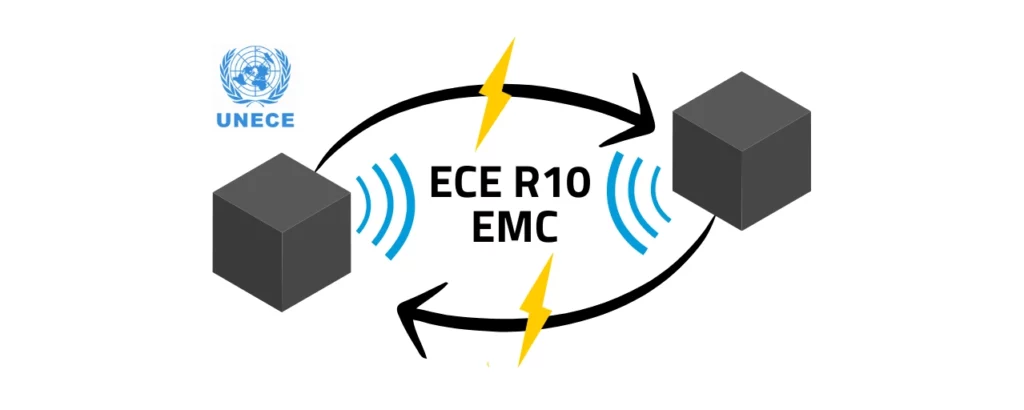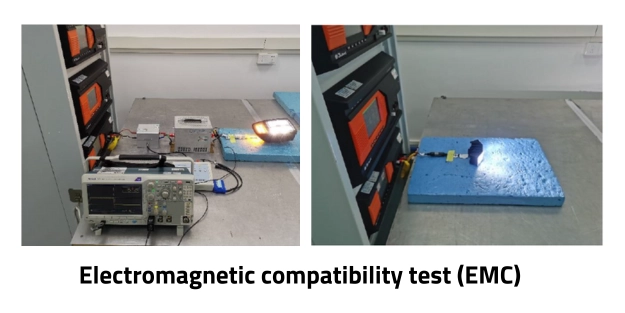What is ECE-R10?
EMC ECE-R10 is a type approval for electrical systems in vehicles, meaning that the lighting must not cause interference with other electrical equipment. At the same time, an ECE-R10 lamp is resistant to electromagnetic radiation from external sources, including other equipment. The abbreviation "ECE" stands for Economic Commission Europe. This commission establishes guidelines that products must comply with and ensures that all products are tested. Read more about EMC interference suppression.

Which products are covered by ECE-R10?
There are a number of products that fall under the scope of ECE-R10. The ECE-R10 regulations include the following:
- Electromagnetic compatibility, all vehicles of categories: L, M, N, O, T, R, S1.
- Components and STU requirements used in these vehicles comply with electromagnetic compatibility.
- Other requirements for vehicle control. Includes directed and radiated disturbances to the function. It could interfere with drivers and other road users. The interference may be due to the functionality of the vehicle data bus. It may also affect the legal vehicle data.
- If the requirements for conducted emission or unwanted radiation are met. Then the unwanted use of electronic equipment in the car or in other vehicles will follow. Also check the use of accessories that may disturb the cars.
- Some other requirements for ESAs and vehicles. It regulates the contact between the power grid and the vehicle. This contact ensures safe emissions and immunity for vehicles.
What are the key aspects of ECE R10?
Interference resistance: In addition to ensuring that the LED lamp itself does not emit interference, LED lamps must also ensure sufficient resistance to external electromagnetic interference.
The "Interference" emission is limited to acceptable levels to enable operation without interfering with other electronic devices. The "Interference" emission is limited to acceptable levels to enable operation without interfering with other electronic devices.
R10 and R65
In addition to the ECE-R10 regulation, you also have ECE 65: this is a European directive that describes the requirements for light and acoustic signals for vehicles and trailers. Since 2014, the ECE R65 regulations apply to a beacon light and LED warning lights. It is important to avoid hazardous situations. It is therefore also important to warn your fellow road user in time when such a vehicle is approaching. Read more about ECE Regulation R65 here.
The ECE R10 Test Procedure: What is tested?
For ECE R10 certification, electronic vehicle components, such as vehicle lighting and other electrical systems, are tested for their electromagnetic compatibility (EMC). This means verifying that these components do not cause electromagnetic interference and are not affected by it. These tests are essential to ensure the safety and reliability of vehicles.
What does the test involve?
The procedure consists of measuring two types of emissions:
- Radiated emissions: The electromagnetic radiation emitted by a component into its surroundings.
- Conducted emissions: The electromagnetic signals transmitted through wiring.
These measurements are conducted over a wide frequency range, typically from 20 MHz to 2000 MHz. The measured emission values are then compared to predetermined limits, which depend on the frequency band.

Test conditions
The tests are conducted under controlled environmental conditions, such as stable temperature and humidity. Both horizontal and vertical polarization are measured to obtain a complete picture of the product's electromagnetic properties.
De resultaten worden geanalyseerd met behulp van geavanceerde meetapparatuur, zoals piekdetectoren. Indien de gemeten emissies onder de vastgestelde limieten blijven, wordt het product goedgekeurd volgens de ECE R10-standaard.
Op welke voertuigen is de norm toepassing?
The ECE-R10 regulation applies to various vehicle categories, including motorcycles, passenger cars, trucks, trailers, agricultural tractors, and other special vehicles. These categories cover a wide range of vehicles commonly found on the road daily, highlighting the broad scope and importance of this standard.
Conducted disturbances are transmitted through the cables within the vehicle and can cause malfunctions in other electronic systems, such as the onboard computer or communication systems between vehicle components. Radiated disturbances, on the other hand, are transmitted through electromagnetic waves in the air and can interfere with wireless communication or other electronic devices, both inside and outside the vehicle.
Products that fall under ECE-R10 must undergo strict testing procedures. These tests, conducted in laboratories and during practical road tests, measure both conducted and radiated disturbances. Only products that meet the stringent requirements receive an ECE-R10 certification. This means they can be used in vehicles without the risk of electromagnetic interference.
Are you looking for an ECE-R10 beacon light, flasher, work light, driving light, or an LED bar? Feel free to take a look at the TRALERT® dealer portal under LED lighting. We offer a wide range of ECE-R10 certified LED lighting.